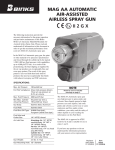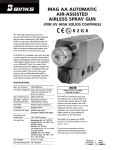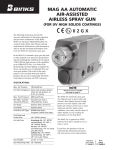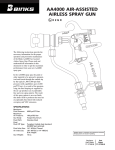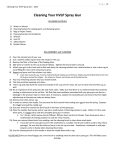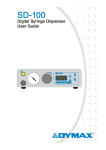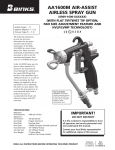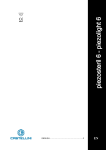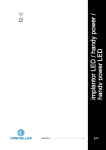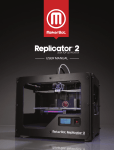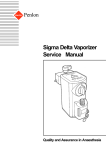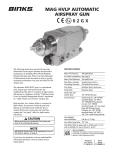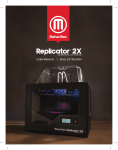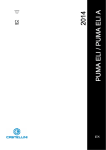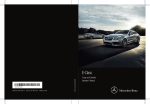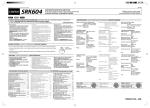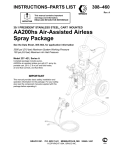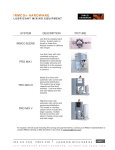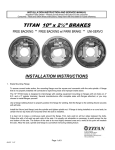Download MAG AA AUTOMATIC AIR4ASSISTED AIRLESS SPRAY GUN ii 2 G X
Transcript
Mag AA Automatic AIR-Assisted AIRLESS Spray Gun II 2 G X The following instructions provide the necessary information for the proper operation and preventive maintenance of the Binks MAG AA Automatic Manifold Mounted AirAssisted Airless Spray Gun. Please read and understand all information in this document in order to get the maximum performance from your new MAG AA Automatic spray gun. In the MAG AA Automatic spray gun, the paint or other material to be sprayed is preatomized and forced through the carbide tip by the typical 1,500-3,800 psi fluid pressure (with capabilities up to 4,000 psi/275 bar). As a result of the preatomizing, the final shaping air supplied by the air cap produces an exceptionally fine and even spray pattern. The result of this spray pattern is an even finish that lends itself to products that need an exceptionally fine finish with reduced overspray and VOC emissions. Specifications: Max. Air Pressure:100 psi/6.8 bar For HVLP compliance:20 psi inlet pressure delivers 10 psi air cap pressure at 8 cfm air volume Max. Fluid Pressure:4000 psi/275 bar Min./Max. Cylinder 50 psi/3.4 bar (min.), Actuating Pressure: 100 psi/6.8 bar (max.) Gun Body:Stainless Steel, Aluminum Fluid Path:Stainless Steel Fluid Shut Off Type:UHMW Seat (std.), Tungsten Carbide Seat (opt.) Fluid Inlet and Outlet Size:1/4" NPT(F) thread Air Inlet Size:Atomizing Air: 1/4" NPT(F) manifold body, 1/4" NPT x 1/4" NPS(M) fitting Fan Air: 1/4" NPT(F) manifold body, 1/4" soc head plug (M) fitting Cylinder Air: 1/8" NPT(F) manifold body, 1/8" NPT x 1/4" O.D. tube fitting Gun Weight:2.5 lbs. (1.1 kg) Gun Mounting Hole:1/2" diameter NOTE Please be sure to read the warnings on page 2. The MAG AA Automatic spray gun uses high pressure to spray paints and solvents. Since liquids sprayed at high pressure can cause injuries, and some paints and solvents can be toxic or cause explosions and fires under certain conditions, your safety and the safety of others depend on your reading the information on this Part Sheet. The MAG AA is approved to ATEX level II 2 G X and is suitable for use in zones 1 and 2. If you have any questions or do not understand the information presented, call your nearest service representative. Replaces Part Sheet 77-2797R-5 Part Sheet 77-2797R-6 ! Warning High Pressure Can cause serious injury if equipment is installed or used incorrectly— Read, Understand, and observe all Warnings and Instructions in this Manual. Flammable, Explosive and Toxic Vapors High Pressure Spray and Hose Leaks Operate equipment only after all instructions are clearly understood. In this part sheet, the words WARNING, CAUTION and NOTE are used to emphasize important safety information as follows: ! WARNING ! Hazards or unsafe practices which could result in severe personal injury, death or substantial property damage. Caution Hazards or unsafe practices which could result in minor personal injury, product or property damage. Injection Hazard Spray from the gun, hose leaks, or ruptured components can inject fluid into your body and cause extremely serious injury, including poisoning or the need for amputation. Splashing fluid in eyes or on skin can also cause a serious injury. • Fluid injected into the skin might look like just a cut, but is a serious injury and should be treated as such. GET IMMEDIATE MEDICAL ATTENTION. INFORM THE PHYSICIAN WHAT TYPE OF MATERIAL WAS INJECTED. • Do not point the spray gun at anyone or any part of the body. • Do not put fingers or hand over the spray tip. • Do not stop or detect fluid leaks with a rag, hand, body or glove. • Do not use a rag to blow back fluid. THIS IS NOT AN AIR SPRAY GUN. • Engage the gun safety when not spraying. • ALWAYS RELIEVE THE PRESSURE WHENEVER WORKING ON THE SPRAY GUN. • Tighten all fluid connections before operating equipment. • Check all hoses, tubes, and couplings daily. Replace all worn, damaged, or loose parts immediately. Hazardous fluids or toxic fumes can cause serious injury or death if splashed on skin or in the eyes, swallowed or inhaled. TOXIC FLUID HAZARD • Know the specific hazards of the fluid you are using. This information is on the MSDS for the material being used. Read all fluid manufacturer’s warnings. • Store hazardous fluids in approved containers only. Dispose of all hazardous fluids in accordance with all state, local and national guidelines. • Wear the appropriate protective clothing, gloves, eyewear and respirator. Equipment misuse can cause the equipment to fail, malfunction, or start unexpectedly and result in serious injury. NOTE Important installation, operation or maintenance information. • Use the equipment only for its intended purpose. If you are unsure about its purpose call your local Binks distributor. • Do not alter or modify this equipment. Use only genuine Binks parts. • Do not exceed the maximum working pressure of the lowest rated system component. THE MAXIMUM RATING OF THE MAG AA Automatic IS 4000 PSI (275 BAR) FLUID PRESSURE. DO NOT EXCEED THE FLUID PRESSURE RATING. • Route all hoses away from all sharp edges, moving parts, hot surfaces and high traffic areas. • Do not use hoses to pull the equipment. • Use only Binks approved hoses. Do not remove spring guards from hoses, these are on the hoses to prevent rupture from kinking at the connectors. • Use only solvents compatible with hoses and wetted parts of the equipment used. • Comply with all applicable local state and national fire, electrical, and other safety regulations. Improper grounding, poor air ventilation, open flames, or sparks can cause a hazardous condition and result in fire or explosion and cause serious injury. FIRE AND EXPLOSION HAZARD • Ground the equipment and object being sprayed. • Provide fresh air ventilation to avoid the build up of flammable fumes from the material being sprayed or from solvent. • Extinguish all open flames or pilot lights in spray area. • Electrically disconnect all equipment in the spray area. • Keep the spray area free from all debris, including solvent rags. • If there is any static sparking while using the equipment, STOP SPRAYING IMMEDIATELY. Identify and correct problem. NOISE LEVELS EQUIPMENT MISUSE HAZARD • The A-weighted sound level of spray guns may exceed 85 dB(A) depending on the setup being used. It is recommended that ear protection is worn at all times when spraying. • This equipment is for professional use only. • Read and understand all instructional manuals, tags, and labels before operating equipment. The automatic Spray Gun models listed in the following declaration of conformity may be used in some potentially explosive atmospheres ONLY when the special conditions for safe installation and operation have been followed as expressed in this user manual (Part Sheet). These models are approved to ATEX regulations 94/9/EC, protection level: II 2 G X: Suitable for use in Zones 1 and 2. EC Declaration of Conformity Manuf. By: Industrial Finishing 195 Internationale Blvd. Glendale Heights, IL 60139 Type/Series: Manifold Mounted Automatic Spray Guns Model: MAG AA: 4001-, 4002The equipment to which this document relates is in conformance with the following standards or other normative references: EN ISO 12100-1&2:2003 and BS EN 1953:1999 and thereby conform to the protection requirements of Council Directive 98/37/ EC relating to Machinery Safety Directive, and; EN 13463-1:2001, Council Directive 94/9/EC relating to Equipment and Protective Systems for use in Potentially Explosive Atmospheres, protection level II 2 G X. Approved By: _ _____________________________ 2 Chuck McCulloch, April 17. 2006 Date:_____________ Industrial Finishing Industrial Finishing reserves the right to modify equipment specification without prior notice. MAG AA Automatic Spray Gun Set-Up INSTRUCTIONS — SPRAY INSTRUCTIONS TO CHANGE FROM COMBINED FAN AND ATOMIZING AIR TO SEPARATE FAN AND ATOMIZING AIR. 1.Remove item (31) side port control by turning counter-clockwise with a 9/16 wrench. 2.Install item (32) set screw into thread at the bottom of tapered cavity of where the side port was. With the gun set up to operate with remote fan air you can accommodate a 40% reduction in pattern width by increasing air pressure to the fan port. GENERAL SPRAY INSTRUCTIONS 1.Have at least 55-60 psi air pressure for the cylinder operating air. 3.Install item (33) side port plug into the upper part of the threaded cavity of where the side port was. 2.To reduce overspray and obtain maximum efficiency, always spray with the lowest possible fluid/air pressure that produces an acceptable pattern. 4.Remove item (29) 1/4 npt plug form the fan air port and replace it with item (35) D.M. nipple. 3.The air line to a three way valve should be as short as possible for rapid operation. SET UP FOR SPRAYING 4.All the air used in the gun should be dirt and moisture free. This is accomplished by using an oil and water extractor. Safe connection. Verify that the gun is grounded per the automated machine manufacturer’s recommendations. Connecting gun to the material hose. Gun should be connected by a suitable length of 3/8" diameter material hose fitted with a the appropriate connector that mounts to the 1/4" npt female thread of the fluid inlet portion of the manifold. 1/4" diameter hose is recommended for use with low viscosity materials. (Fluid hoses of different composition are available for special fluids.) Connecting atomizing air to the manifold. Guns should be connected by a suitable length of 5/16" diameter air hose fitted with a connector that accommodates a 1/4" nps (m) fitting and should connected the atomizing air port. Connecting air cylinder to the manifold. Connect 1/4" O.D. tubing to the air cylinder fitting located on the manifold. Controlling the material flow. When fed from a pressure supply, an increase in material pressure will increase the rate of flow. Correct fluid tip size ensures correct material flow rate. Adjusting the spray pattern. Utilizing the AA4 air cap and adjusting side port control you can get a 20% range of pattern Adjustment. 5.Shut off all the fluid and air lines to the gun if the gun is to stand idle for any length of time. This is to prevent build-up or accumulation of minute leaks in the system from turning the gun on. 6.The distance between gun and surface should be 6 to 12 inches depending on material and the atomizing pressure. The material deposited should always be even and wet. Lap each stroke over the proceeding stroke to obtain a uniform finish. 7.Set the fluid pressure to achieve low pressure airless pattern with tails approximately 300 to 500 psi. 8.Open the side port control knob. 9.Set the atomizing pressure to 5 psi and increase until the tails have been removed from the pattern and proper atomization has been achieved. If more than 30 psi of atomizing air is required, increase fluid pressure instead of atomizing air. 10.Note: Excessive fluid/air pressure will distort the spray pattern and produce excessive overspray. The “hourglass” and “tails” on a spray patterns indicate too low of fluid/air pressure or materials is too thick or viscous. A worn or clogged tip can also cause spray pattern distortion. Fluid Tip Selection Factors to consider in selecting a fluid tip for an airassisted airless spray gun include (1) the size of the parts being sprayed; (2) the production line speed; (3) the material flow rate and film thickness; (4) the viscosity of the material applied; (5) the type of material applied; and (6) the quality of atomization of the coating required. The selection of a fluid tip necessary to perform a specific spraying job is best determined through a combination of experimentation and expert advice from your material and equipment suppliers. 3 Troubleshooting defective spray patterns The following procedure summarizes the steps that an operator must immediately take when the first signs of a defective spray pattern emerge. 1.Check the external portion of the fluid tip for material buildup. If buildup has occurred, secure the gun trigger safety switch and clean the gun fluid tip with a non-metal soft brush. 2.If the spray pattern exhibits signs of tails at the top or bottom ends of the pattern, increase the air pressure gradually until the tails disappear. 3.If increasing air pressure does not dissipate the tails, the fluid tip may be worn and may need to be replaced. Another sign of the need to replace a worn tip is a gradual decline in spraying pattern width. 4.If cleaning or replacing the fluid tip does not dissipate the tails; the spraying defect is most likely due to the material temperature and/or viscosity. 5.If pattern pulsation or blinking occurs, check the pressure regulators, all downstream regulators, and the pump. These may require further adjustment or even repairs. Distorted Pattern Tails Hour Glass Correct Pattern Figure 3 Spray Pattern troubleshooting ProblemCauseAction Fluttering Spray Pattern Insufficient fluid supply.Adjust fluid regulator or fill fluid supply tanks. Air in paint supply line.Check and tighten pump siphon hose connections, bleed air from paint line. Striping Spray – Fingers Tip partially plugged. Clean or replace tip assembly. Irregular Pattern Fluid builds up on tip, or tip partially plugged. Clean tip. On defective side of pattern, air horn holes are plugged. Clean air horn holes with solvent and a soft brush. Pattern pushed to one side, same side of air cap gets dirty On defective side of pattern, air horn holes are plugged. Clean air horn holes with solvent and a soft brush or toothpick. IMPORTANT REGULATORY NOTE The MAG AA Automatic manifold mounted air-assisted automatic spray gun combines the proven efficiency of the Binks compliant spray guns with air-assisted atomization to yield a reliable, carefully engineered compliant spray gun. With 25' of 5/16" I.D. air hose and regulator set at only 20 p.s.i. the compliant air cap registers 10 p.s.i. of atomization air to shape and soften the spray pattern. The MAG AA Automatic manifold mounted air-assisted automatic spray gun operates at high transfer efficiencies and fully complies with all government regulations for H.V.L.P. spray guns. Max. Fluid Input: ax. static air pressure at regulator with 25' of hose to inlet: M Max. Dynamic Gun Inlet Air Pressure: Gun Body: Fluid Path: 4 4000 p.s.i. 20 p.s.i. 15 p.s.i. Stainless Steel, Aluminum Stainless Steel s NOTE disassemble spray gun and remove all o-rings before immersing gun in or subjecting it to a flood-wash of cleaning solvent. contact with solvents may induce o-ring swelling beyond their specification sizes and cause subsequent malfunction of the gun. PTFE (copper #540 395) based grease Use PTFE to lubricate all o-rings and moving parts before reassembly into the gun body. To further protect the environment, avoid storing solvents or solvent-soaked wipes, such as those used for surface preparation and cleanup, in open or absorbent containers. tRoUBLeSHootinG Numbers in parentheses refer to individual items shown in the “exploded” drawing on page 7. ! caution never use metal instruments to clean or scrape fluid or air nozzles. these parts have been carefully machined and altering their shape will cause faulty spray. ! caution never use lubricants containing silicone since these lubricants can cause finish defects. Binks Gunners Mate is recommended. NING ! Be sure to follow all safety precautions described on page 2 before working on the spray gun. never work on the spray gun until fluid pressure has been relieved throughout the system and the power or air supply for the fluid pump has been disconnected. always test the repaired gun for leaks with low pressure fluid before use. SeRVicinG/RePLacinG aiR caP, caRBide tiP and fLUid Seat aSSeMBLY Service symptoms: •Build-uponaircapor cloggedcarbidetip •Fluidseatassemblynot sealingproperly 1. Turn retaining ring (16) counterclockwise and remove. 2. Remove air cap (17) and carbide tip assembly (18) from fluid seat assembly (19). With the air cap facing up, apply pressure to carbide tip (18) and remove from air cap (17). 3. Turn fluid seat assembly (19) counterclockwise and remove. 4. Service or replace and reassemble in reverse order. NOTE carbide fluid tip needs to be oriented properly in the air cap. the alignment pin in the air cap is to be properly positioned to the slot in the carbide tip. RePLacinG fLUid caRtRidGe aSSeMBLY Service symptoms: •Fluidleakingfromweepsport 1. Turn end cap (1) counterclockwise and remove it and the piston return spring from the piston body (23). 2. With two 5/16" wrenches (not supplied with gun), loosen collet locknut (9) from collet (10). 3. Using a pair of pliers, grip collet (10) and remove piston assembly (5). 4. Place the 3/8" deep socket (supplied with gun) over cartridge assembly (15) and turn counterclockwise. 5. Remove and reassemble in reverse order using the new cartridge assembly. NOTE Piston assembly (5) must be bottomed out on the piston housing (23) with collet (10) and locknut (9) positioned such that the e-clip (12) is resting against the piston assembly. NOTE if the piston is not positioned correctly, the fluid-to-air timing will not work correctly. See pictorial view on page 6. 6. After the piston assembly has been positioned properly, tighten locknut (9) to collet (10) “wrench tight”. RePLacinG o-RinGS on PiSton aSSeMBLY Service symptoms: •Atomizingairnotcyclingoff •Airnotactuatingfluid 1. Turn end cap (1) counterclockwise and remove it and the piston return spring from the piston body (23). 2. With two 5/16" wrenches (not supplied with gun), loosen collet locknut (9) from collet (10). 3. Using a pair of pliers, grip collet (10) and remove piston assembly (5). 4. Replace o-rings (7, 8, 13 & 14) using Standard Piston O-ring Repair Kit 54-5303 or High Performance Piston O-ring Repair Kit 54-5307. 5. Apply MG75 PTFE based lubricant provided in the o-ring repair kits to o-rings and reassemble in reverse order. NOTE Piston assembly (5) must be bottomed out on the piston housing (23) with collet (10) and locknut (9) positioned such that the e-clip (12) is resting against the piston assembly. NOTE if the piston is not positioned correctly, the fluid-to-air timing will not work correctly. See pictorial view on page 6. 6. After the piston assembly has been positioned properly, tighten locknut (9) to collet (10) “wrench tight”. SeRVicinG/RePLacinG fiLteR Service symptoms: •Fluidtipcloggingorrestriction influidflow 1. Using a 3/4" inch wrench, turn filter retainer (27) counterclockwise and remove. 2. Place a standard screwdriver inside the cavity where the filter (30) is housed and dislodge it by lifting up with the screwdriver. Remove filter and clean or replace as required. Most of the time you can dislodge the filter using your finger. 3. Reassemble in reverse order. NOTE o-ring (28) does not require replacement when servicing filter. Replace o-ring (28) if a leak develops around filter retainer (27). ReMoVinG/RePLacinG GUn aSSeMBLY ModULe onLY fRoM inLet ManifoLd aSSeMBLY 1. Using a 9/64" Allen wrench (supplied with gun), turn retaining cap screw (20) counter-clockwise typical 4 places and remove gun sub module. NOTE o-rings (22 & 24) must be replaced when replacing gun sub module. 2. Mount the new gun module, tightening the retaining screws (20) “wrench tight”. This will allow fluid and air passages to seal with no contamination. 5 MaG aa aUtoMatic MoUntinG SPecificationS 5 9/16" 1.750 .966 1/4" O.D. TUBE X 1/8"NPT FITTING CYLINDER AIR Piston Assembly Piston Housing 2.700 SIDE PORT AIR FAN ADJUSTMENT 1.282 1.201 1.826 1/4"NPT(F) FAN AIR INLET MaG aa aUtoMatic PiSton PoSitioninG PISTON VENT AND FLUID .704 BY-PASS WEEP PORT 1/4"NPT(F) FLUID 1/2" DIA HOLE INLET TYPICAL 1.470 FOR GUN MOUNTING ROD BOTH SIDES SET SCREW FOR ROD MOUNT OR 1/4"NPT(F) SINGLE BOLT ADAPTER MOUNT ATOMIZING AIR INLET 3.158 2.306 .402 Install piston assembly into piston housing. Be sure all o-rings are properly lubricated PTFEbased with MG75 PTFE lubricant provided with o-ring repair kits. .402 Piston Assembly oPtionaL adaPteR PLate MoUntS aRe LiSted on PaGe 8 1.375 8-32 X 3/16" DEEP TYPICAL 8 PLACES PLate MoUntinG SPecificationS MaG aa aUtoMatic HoSe HooK-UPS Piston assembly must be bottomed out in the piston housing. INED Collet FLUID RETURN G SPRA Y GU N IZI M O AT N CY LIN DE ATOMIZING AIR REGULATOR RA IR PLUG R AI GROUND Lift the collet until it stops and hold in an upright position while inserting a 5/16" wrench onto the collet. CYLINDER AIR SOLENOID (3-WAY) Collet Locknut FLUID SUPPLY FILTER ATED FLUID RETURN G IN IZ M SPRA Y GU O AT N Insert and tighten the collet locknut using a second 5/16" wrench and “wrench tighten”. R AI CYLINDER AIR FA N AI R ATOMIZING AIR REGULATOR CYLINDER AIR SOLENOID (3-WAY) 3/16" GROUND FLUID SUPPLY 6 FAN AIR REGULATOR FILTER If properly assembled, bottom of collet should be 3/16" from the top of the piston assembly. N 15 14 13 12 15b 5 11 15a 10 9 8 7 16 6 20 4 17 18 PaRtS LiSt 19 3 2 1 20 19a 21 When ordering, please specify Part No. (Not all part numbers are available for purchasing) TION 22 QtY. 23 20 22 24 25 22 27 28 30 36 29 35b 32 31 34 33 oPtionaL SetUP: ITEMS 32 AND 33 MAY REPLACE ITEM 31 (SIDE PORT ASSEMBLY) WHEN ITEM 31 IS NOT REQUIRED. PTFE 29 26 TION PTFE 37 PTFE Flathead Allan HD Pltd .............1 102-2839★ Side Port Plug ............................1 20-1359-1 Screw Sq HD 5/16-18 x 5/8 ........1 QtY. PTFE 33 34 35a 20-6782 ‡ (1/8 NPT(W) x 1/4 Tubing) .........1 Allen Skt HD 8-32 x 1-3/4 Lg .....2 Tools provided with spray gun: 20-3586ALLENWRENCH(9/64") 20-6571SOCKETWRENCH(3/8") • AvailableaspartofRebuildKit54-5307.HighPerformanceSealKit. ▲ AvailableaspartofPistonAssembly54-5355. 54-5355isapartof54-5315andisavailablesparately. ✚ AvailableaspartofPistonColletRepairKit54-5304. Alsoavailable:20-6750-K10(Kitof10O-ringsforAA4Aircap). ■ Availableaspartof20-6037-K10SoftSealKit(10rings). ‡ Availableaspartof54-5333-K6. ★ ItemNos.32,33and35bareprovidedinaseparatebag. 7 MAG AA Automatic MANIFOLD MOUNTED AIR ASSISTED AIRLESS SPRAY GUN Repair & Cleaning KitS Airless Spray Tip – Fluid Flow Rate* part No. description 20-6750-K10 Kit of 10 O-rings (for AA4 air cap) 54-4994Cleaning Kit: includes one standard stiff nylon pipe cleaning brush, full-size nylon brush, tip cleaner, and Binks Gunners Mate Lubricant 54-5303 Standard Performance Seal Kit 54-5304 Piston Collet Repair Kit 54-5307 High Performance Seal Kit 54-5305Optional Mount “K” Kit: includes adapter plate assembly 54-5306CEFLA Fluid Fitting Kit 54-5315 Piston Assembly AA Gun 54-5399 Single Bolt CEFLA Adapter Kit Orifice Size 500 PSI 1000 PSI 1500 PSI (Inches) oz./min. oz./min. oz./min VERY THIN – Wash Primers, Dyes, Stains, Solvents .009 5.1 7.1 8.2 .011 8.1 11.5 13.6 .013 11.7 17 19.9 THIN – Sealers, Lacquers, Primers, Ink, Zinc Chromate .015 16.5 23.3 27.8 .017 21 30.2 35.9 MEDIUM – Lacquers, Synthetics, Enamels, Varnishes .019 26.6 37.8 45.6 .021 32.8 45.8 56.8 .024 39.7 56.1 68.7 .027 50.4 71.2 87.2 Fluid SeatS part No. description 54-4926Standard UHMW Fluid Seat 54-4960Optional Tungsten Carbide Fluid Seat Flow rate of fluid materials through spray tip, oz./min. * Based on 1000 PSI with water. Actual results may vary, depending on material viscosity. Fluid Filter part No. description 54-1835100 Mesh Filter Air Caps part No. description AA-2 - 54-4980 Thin to Medium Materials AA-4 - 54-4978 Medium to Heavy Materials ACCESSORIES part No. 54-4997 54-5022 54-380 54-3691 description HVLP Test Gauge AA2 HVLP Test Gauge AA4 Gun Mounting Bracket Gun Covers (Package of 20) How to Order the MAG AA Automatic Spray Gun WITH MANIFOLD 4001-0000-0 MAG AA Automatic Spray Gun WITH MANIFOLD, less Air Cap and Spray Tip 4001-0000-2 MAG AA Automatic Spray Gun WITH MANIFOLD & AA2 AIR CAP, less Spray Tip 4001-0000-4 MAG AA Automatic Spray Gun WITH MANIFOLD & AA4 AIR CAP, less Spray Tip How to Order the MAG AA Automatic Spray Gun WITHOUT MANIFOLD 4002-0000-0 MAG AA Automatic Spray Gun WITHOUT MANIFOLD, less Air Cap and Spray Tip 4002-0000-2 MAG AA Automatic Spray Gun WITHOUT MANIFOLD, WITH AA2 AIR CAP, less Spray Tip 4002-0000-4 MAG AA Automatic Spray Gun WITHOUT MANIFOLD, WITH AA4 AIR CAP, less Spray Tip Spray tips must be ordered separately. Use the spray tip selection chart to determine orifice size and fan size required. Industrial Finishing Binks has authorized distributors throughout the world. For technical assistance or the distributor nearest you, see listing below. U.S./Canada Technical Service Office: 195 Internationale Blvd., Glendale Heights, IL 60139 Toll-Free Telephone: 1-888-992-4657 (U.S.A. and Canada only) Toll-Free Fax: 1-888-246-5732 Spray Tip Selection ChartS Fan width based on 1000 PSI with water. Actual results may vary, depending on material viscosity. Tip Assembly orifice Part No. 114-00702 114-00704 114-00706 114-00707 114-00902 114-00904 114-00906 114-00908 114-00910 114-00912 114-01104 114-01106 114-01108 114-01110 114-01112 114-01114 114-01304 114-01306 114-01308 114-01310 114-01312 114-01314 114-01316 114-01506 114-01508 114-01510 114-01512 114-01514 114-01516 114-01518 .007 .007 .007 .007 .009 .009 .009 .009 .009 .009 .011 .011 .011 .011 .011 .011 .013 .013 .013 .013 .013 .013 .013 .015 .015 .015 .015 .015 .015 .015 fan Width (In.) GPM Capacity @500 PSI Water 2 4 6 8 2 4 6 8 10 12 4 6 8 10 12 14 4 6 8 10 12 14 16 6 8 10 12 14 16 18 .028 .028 .028 .028 .039 .039 .039 .039 .039 .039 .060 .060 .060 .060 .060 .060 .090 .090 .090 .090 .090 .090 .090 .120 .120 .120 .120 .120 .120 .120 Tip Assembly orifice Part No. 114-01706 114-01708 114-01710 114-01712 114-01714 114-01716 114-01718 114-01816 114-01906 114-01908 114-01910 114-01912 114-01914 114-01916 114-01918 114-02110 114-02112 114-02114 114-02116 114-02118 114-02410 114-02412 114-02414 114-02416 114-02418 114-02710 114-02712 114-02714 114-02716 114-02718 .017 .017 .017 .017 .017 .017 .017 .018 .019 .019 .019 .019 .019 .019 .019 .021 .021 .021 .021 .021 .024 .024 .024 .024 .024 .027 .027 .027 .027 .027 fan Width (In.) GPM Capacity @500 PSI Water 6 8 10 12 14 16 18 16 6 8 10 12 14 16 18 10 12 14 16 18 10 12 14 16 18 10 12 14 16 18 .160 .160 .160 .160 .160 .160 .160 .180 .190 .190 .190 .190 .190 .190 .190 .240 .240 .240 .240 .240 .310 .310 .310 .310 .310 .385 .385 .385 .385 .385 WARRANTY This product is covered by Binks’ 1 Year Limited Warranty. Binks Worldwide Sales and Service Listing: www.binks.com 77-2797R-6 Revisions: (P8) Replaced Spray Tip Selection Charts. 6/10 © 2010 Inc. All rights reserved. Printed in U.S.A.








